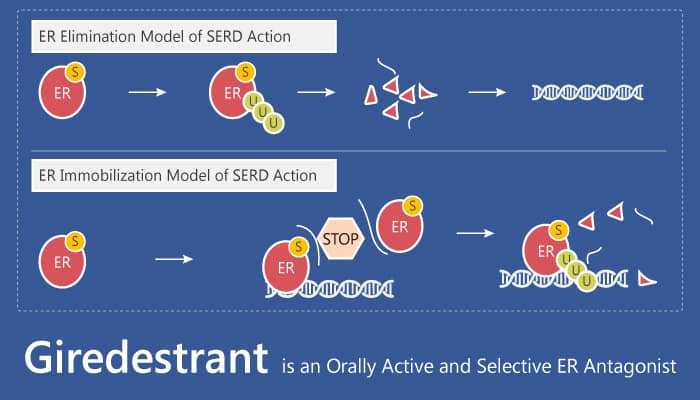Estrogen receptor (ERs) is a group of proteins found in cells and is activated by estrogen. Specifically, ERs are typical members of the nuclear receptor superfamily, including receptors that mediate steroid hormones, thyroid hormones, vitamin A and vitamin D, and many orphan receptors. Besides, once ER is activated, estrogen can be transferred to the nucleus and bound to DNA, thus regulating the activity of different genes. Like other steroid receptors, ER mainly acts as ligand inducible transcription factors, which bind chromatin on specific reaction elements. Moreover, ER+ breast cancer depends on ER signal transduction in the whole process of disease progression. Dysfunction of ER pathway can lead to many diseases, such as hormone-dependent breast cancer, endometrial cancer and ovarian cancer, and so on. Giredestrant (GDC-9545) is an orally active and selective estrogen receptor (ER) antagonist.

Giredestrant is an orally active and selective estrogen receptor (ER), antagonist.
But, how does Giredestrant protect against cancer cells via ER? Let’s discuss it in detail. In the beginning, Giredestrant is a non-steroidal ER ligand and an orally active and selective ER antagonist. Meanwhile, Giredestrant potently competes with estradiol for binding and induces a conformational change within the ER ligand-binding domain. Nonetheless, Giredestrant has anti-tumor activity.
In the second place, Giredestrant is a clinical candidate that combines desirable mechanistic and pre-clinical DMPK attributes. Importantly, Giredestrant has highly potent in vivo efficacy. And this is due to the particular combination of high binding potency, full suppression of ER signaling, and an improved DMPK profile. Particularly, Giredestrant has low metabolism and improved oral bioavailability, which led to the overall improvement of oral exposure in many species.
All in all, Giredestrant is an orally active and selective estrogen receptor (ER) antagonist with anti-tumor activity.
References: